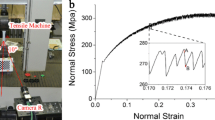Abstract
There are displacement systematic errors due to undermatched shape functions and strain systematic errors due to undermatched surface fitting functions using the digital image correlation (DIC) method. The measured displacement and strain results are heavily affected by the calculation parameters (such as the subset size, the grid step, and the strain window size) due to undermatched shape functions and surface fitting functions. To evaluate the systematic errors, theoretical and numerical analyses of displacement and strain systematic errors have been carried out when the first- and second-order shape functions, and the quadric surface fitting functions are used. When the forth-order Taylor expansion is employed for the displacement, the results come out: (1) the approximate displacement systematic errors are functions of the second- and forth-order displacement gradients when first- and second-order shape functions are used, respectively; (2) the approximate strain systematic errors are functions of the third-order displacement gradients when first-order shape functions are used, and functions of the third- and fifth-order displacement gradients when second-order shape functions are used.
Access provided by CONRICYT-eBooks. Download conference paper PDF
Similar content being viewed by others
Keywords
- Digital image correlation
- Shape functions
- Surface fitting functions
- Displacement systematic errors
- Strain systematic errors
16.1 Introduction
The measurement accuracy of the digital image correlation (DIC) method has become a major concern for the researchers and users. There are many reports on the measurement errors in uniform deformations [1–3]. Studies indicate that the measurement errors include random errors and systematic errors. The random errors are caused by the image noise and other experimental noise [1]. The systematic errors are mainly caused by the imperfect sub-pixel interpolation algorithm including the interpolation bias [2] and the noise-induced bias [3]. For heterogeneous deformations, the undermatched shape functions heavily affect the measurement errors [4], especially in local deformations with high gradients [5]. Schreier built a theoretical model for quantifying the systematic errors due to undermatched shape functions, and employed a second-order deformation to analyze the relationship between the systematic errors and the subset size [6]. However, further solutions for local deformations had not be discussed yet.
This work is organized as follows. Section 16.2 deduces the theoretical estimations and approximations of the displacement and strain systematic errors. Section 16.3 validates the theoretical estimations and approximations through simulated experiments. Section 16.4 draws conclusions from this work.
16.2 Derivation
The measured displacements by the first- and second-order shape functions are expressed in Eqs. (16.1) and (16.2), respectively. The parameter M represents half width of the subset.
The displacement systematic errors are shown in Eqs. (16.3) and (16.4). Note that the third- and fifth-order Taylor expansions for the displacement field u(x,y) are used when the first- and second-order shape functions are employed, respectively.
The strain systematic errors are shown in Eqs. (16.5) and (16.6). The parameter G represents the grid step, and the parameter N represents half width of the strain window.
16.3 Validation
The displacement and strain systematic errors when a sine function shaped deformation is employed are shown in Fig. 16.1a, b, respectively. The systematic errors due to second-order shape functions are much smaller than that due to first-order shape functions.
16.4 Conclusion
This work mainly focuses on the systematic errors due to undermatched shape functions and surface fitting functions in local deformations. To evaluate the systematic errors, theoretical estimations have been deduced when undermatched shape functions and quadric surface fitting functions are employed. The results indicate: (1) the approximate displacement systematic errors are proportional to the second- and forth-order displacement gradients when first- and second-order shape functions are used, respectively; (2) the approximate strain systematic errors are functions of the third-order displacement gradients when first-order shape functions are used, and functions of the third- and fifth-order displacement gradients when second-order shape functions are used. The results have been demonstrated through simulated experiments.
References
Gao, Z.R., Xu, X.H., Su, Y., Zhang, Q.C.: Experimental analysis of image noise and interpolation bias in digital image correlation. Opt. Lasers Eng. 81, 46–53 (2016)
Su, Y., Zhang, Q.C., Gao, Z.R., Xu, X.H., Wu, X.P.: Fourier-based interpolation bias prediction in digital image correlation. Opt. Exp. 23(15), 19242–19260 (2015)
Su, Y., Zhang, Q.C., Gao, Z.R., Xu, X.H.: Noise-induced bias for convolution-based interpolation in digital image correlation. Opt. Exp. 24(2), 1175–1195 (2016)
Bornert, M., Brémand, F., Doumalin, P., et al.: Assessment of digital image correlation measurement errors: methodology and results. Exp. Mech. 49(3), 353–370 (2009)
Xu, X.H., Su, Y., Cai, Y.L., Cheng, T., Zhang, Q.C.: Effects of various shape functions and subset size in local deformation measurements using DIC. Exp. Mech. 55(8), 1575–1590 (2015)
Schreier, H.W., Sutton, M.A.: System errors in digital image correlation due to undermatched subset shape functions. Exp. Mech. 42(3), 303–310 (2002)
Author information
Authors and Affiliations
Corresponding author
Editor information
Editors and Affiliations
Rights and permissions
Copyright information
© 2017 The Society for Experimental Mechanics, Inc.
About this paper
Cite this paper
Xu, X., Zhang, Q. (2017). Theoretical and Numerical Analyses of Systematic Errors in Local Deformations. In: Sutton, M., Reu, P. (eds) International Digital Imaging Correlation Society. Conference Proceedings of the Society for Experimental Mechanics Series. Springer, Cham. https://doi.org/10.1007/978-3-319-51439-0_16
Download citation
DOI: https://doi.org/10.1007/978-3-319-51439-0_16
Published:
Publisher Name: Springer, Cham
Print ISBN: 978-3-319-51438-3
Online ISBN: 978-3-319-51439-0
eBook Packages: EngineeringEngineering (R0)





